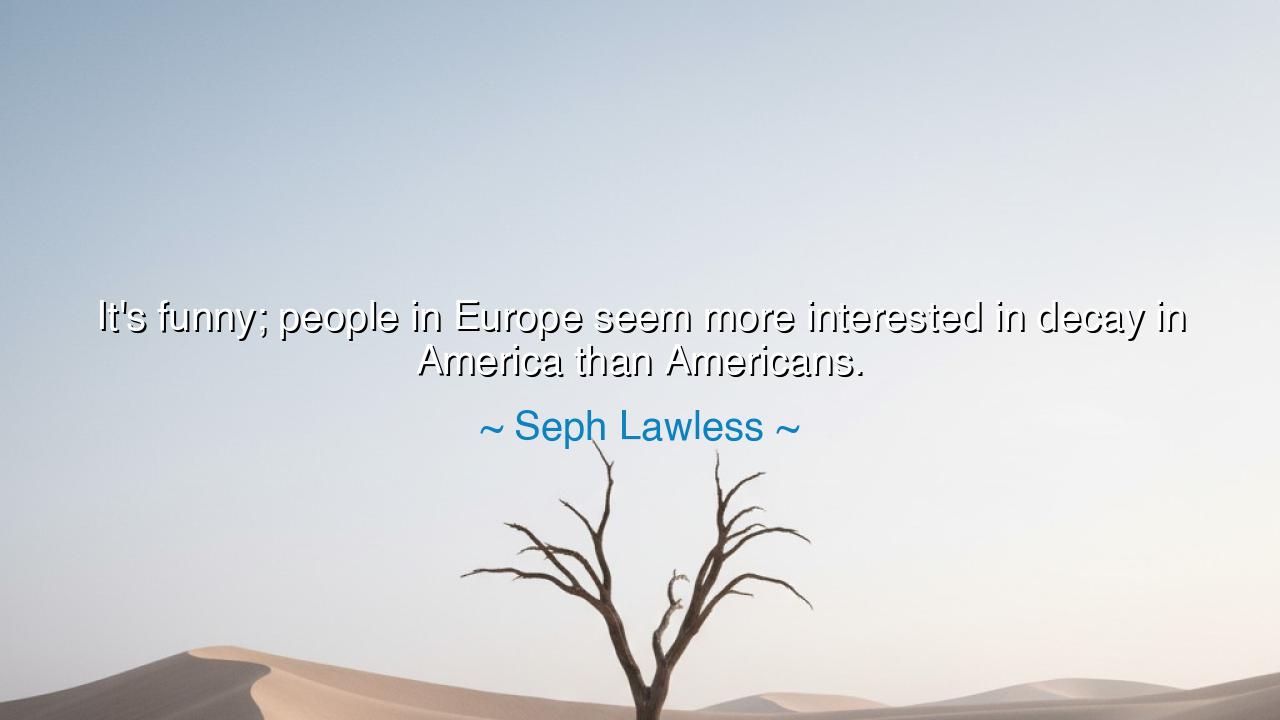
It's funny; people in Europe seem more interested in decay in






Hear now, O children of reflection, the words of Seph Lawless, the modern chronicler of ruins, who said: “It’s funny; people in Europe seem more interested in decay in America than Americans.” Though his words are spoken softly, they resound like a bell struck in the ruins of an abandoned city. For within them lies not just irony, but a meditation on memory, impermanence, and denial—the strange way in which a people turn their eyes from the crumbling symbols of their own creation. Lawless, a photographer and documentarian, has walked the hollowed corridors of America’s forgotten places—its abandoned factories, schools, and malls—and through his lens, he reveals the silent poetry of decline.
When he speaks of “decay”, he speaks not merely of rusted iron or shattered glass, but of the passing of an era—the death of the American dream as it was once imagined. Yet he observes, with both wonder and sorrow, that it is often Europeans who gaze upon his images with fascination, while Americans, whose soil bears the ruins, look away. Why is this so? Perhaps because distance grants the courage to see what closeness cannot. Those across the sea, raised among ancient ruins and fallen empires, understand that decay is not an end, but a story. The coliseums of Rome, the cathedrals of France, the castles of Germany—these are scars turned sacred, monuments not of loss but of endurance. But America, young and proud, fears to see its own wounds.
This is the nature of nations, and of people: to revere the decay of others while denying one’s own. Seph Lawless, in his journeys through the rust-belt cities and forgotten suburbs, has become a mirror to a civilization that worships progress yet forgets its past. In his photographs, the malls of the 1980s stand empty, the houses of Detroit sag like tired hearts, and the laughter of once-thriving towns has turned to wind. To those far away, this decay is beautiful—a haunting glimpse into the fragility of prosperity. But to those who live among it, it is unbearable, a reminder that time spares nothing, not even the dreams of modern man.
The ancients knew this truth well. Consider Ozymandias, the once-mighty king immortalized by the poet Shelley. His statue stood tall in the desert, inscribed with arrogance: “Look on my works, ye Mighty, and despair!” Yet around him stretched only sand and ruin. The Europeans who now look upon America’s decay are the inheritors of countless Ozymandiases; they have seen empires rise, burn, and crumble to dust. Thus, they can admire the beauty in impermanence. But America, still caught in its youth, cannot yet bear to see itself reflected in the bones of its own empire. It looks away from decay because it has not yet made peace with mortality.
And yet, Lawless’s observation carries hope as well. For to see decay—to truly look at it—is to awaken wisdom. Decay is not destruction; it is the truth unveiled. Every building that crumbles, every dream that fades, teaches that all things are transient, that beauty and ruin are bound together. Those who dare to face decay learn humility; they learn that nothing man-made endures forever, and that only what is authentic—love, kindness, art, and understanding—transcends time’s slow erosion. The Europeans’ fascination, then, is not morbid curiosity, but reverence for the cycle of creation and collapse. It is the acknowledgment that from the ashes of the old, the new may rise with deeper roots.
Let us take this lesson not only for nations, but for ourselves. Each of us, too, builds monuments—our ambitions, our possessions, our masks of perfection. And each of us, too, fears to see them decay. But decay is the teacher that pride ignores. When relationships falter, when youth fades, when dreams crumble, remember what Seph Lawless reveals: that even in ruin, there is art, there is truth, there is beauty. To look upon our own decay without despair is to achieve wisdom. To deny it is to remain forever a stranger to the passage of time.
Therefore, my children of the modern age, do not avert your eyes from the ruins, whether they are made of steel or spirit. Walk among them, and listen to their silence. The cracked walls, the peeling paint, the echoes of forgotten laughter—all are telling you this: everything changes, and that is not tragedy, but nature. If the Europeans can find wonder in America’s decline, then you, too, can find peace in your own impermanence. For it is not decay that defines us, but how we face it—with fear, or with understanding.
So remember the words of Seph Lawless as a whisper of truth passed down through the ruins of time: to see decay clearly is to see life fully. What fades teaches us what matters. What crumbles reminds us to build with care. And in the stillness of abandoned places, we may finally learn the most enduring wisdom of all—that even in the silence of ruin, the human spirit still sings.






AAdministratorAdministrator
Welcome, honored guests. Please leave a comment, we will respond soon